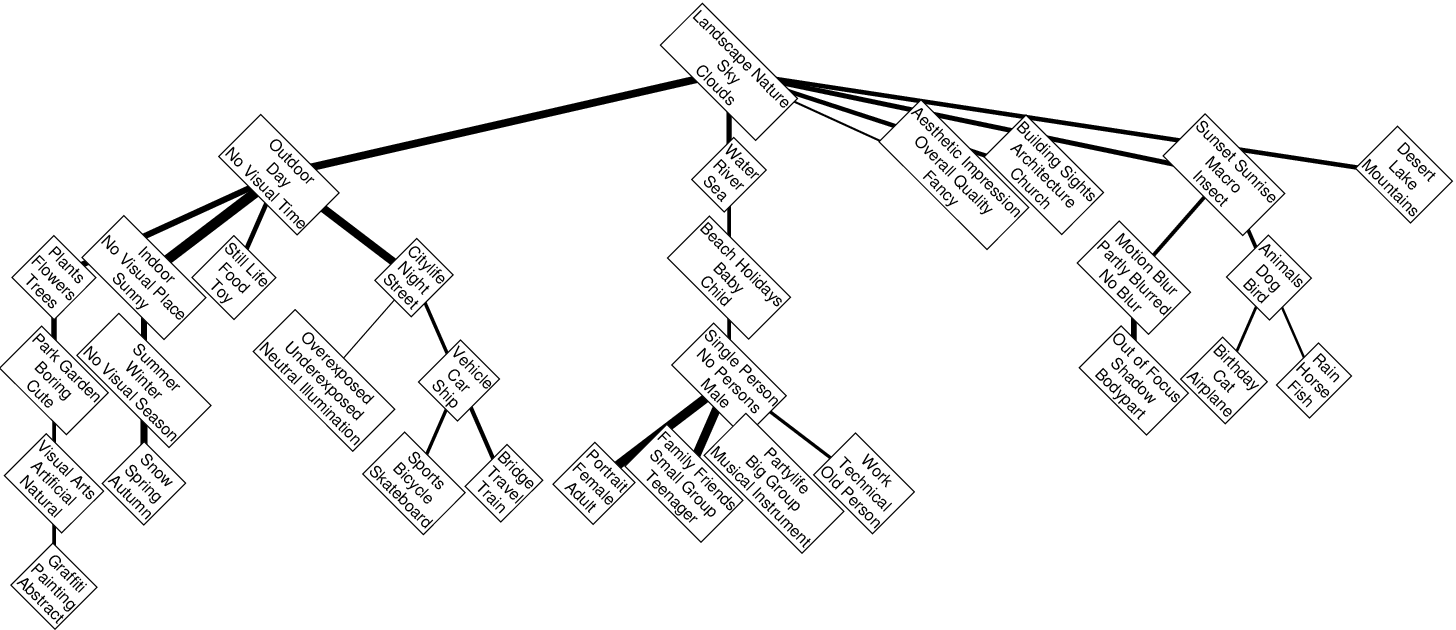Section: New Results
Learning and structuring of visual models
Learning to rank and quadratic assignment
Participants : Thomas Mensink, Jakob Verbeek, Tiberio Caetano [NICTA Canberra] .
In [16] we show that the optimization of several ranking-based performance measures, such as precision-at-k and average-precision, is intimately related to the solution of quadratic assignment problems, especially when the score function allows for pairwise label dependencies. Both the task of test-time prediction of the best ranking and the task of constraint generation in estimators based on structured support vector machines can all be seen as special cases of quadratic assignment problems. Although such problems are in general NP-hard, we identify a polynomially-solvable subclass (for both inference and learning) that still enables the modeling of a substantial number of pairwise rank interactions. We show preliminary results on a public benchmark image annotation data set, which indicates that this model can deliver higher performance over ranking models without pairwise rank dependencies. This work was performed during a visit to NICTA Canberra by T. Mensink (March – June, '11) and J. Verbeek (May '11).
|
Learning structured prediction models for interactive image labeling
Participants : Thomas Mensink, Jakob Verbeek, Gabriela Csurka [Xerox RCE] .
In [25] we propose structured models for image labeling that take into account the dependencies among the image labels explicitly. These models are more expressive than independent label predictors, and lead to more accurate predictions. While the improvement is modest for fully-automatic image labeling, the gain is significant in an interactive scenario where a user provides the value of some of the image labels. Such an interactive scenario offers an interesting trade-off between accuracy and manual labeling effort. The structured models are used to decide which labels should be set by the user, and transfer the user input to more accurate predictions on other image labels. Experimental results on three publicly available benchmark data sets show that in all scenarios our structured models lead to more accurate predictions, and leverage user input much more effectively than state-of-the-art independent models. See Figure 2 .
Modeling spatial layout with Fisher vectors for image categorization
Participants : Frédéric Jurie [University of Caen] , Josip Krapac, Jakob Verbeek.
In [15] we introduce an extension of bag-of-words image representations to encode spatial layout. Using the Fisher kernel framework we derive a representation that encodes the spatial mean and the variance of image regions associated with visual words. We extend this representation by using a Gaussian mixture model to encode spatial layout, and show that this model is related to a soft-assign version of the spatial pyramid representation. We also combine our representation of spatial layout with the use of Fisher kernels to encode the appearance of local features. Through an extensive experimental evaluation, we show that our representation yields state-of-the-art image categorization results, while being more compact than spatial pyramid representations. In particular, using Fisher kernels to encode both appearance and spatial layout results in an image representation that is computationally efficient, compact, and yields excellent performance while using linear classifiers.
Unsupervised metric learning for face identification in TV video
Participants : Ramazan Cinbis, Jakob Verbeek, Cordelia Schmid.
The goal of face identification is to decide whether two faces depict the same person or not. In [8] we address the identification problem for face-tracks that are automatically collected from uncontrolled TV video data. Face-track identification is an important component in systems that automatically label characters in TV series or movies based on subtitles and/or scripts: it enables effective transfer of the sparse text-based supervision to other faces. We show that, without manually labeling any examples, metric learning can be effectively used to address this problem. This is possible by using pairs of faces within a track as positive examples, while negative training examples can be generated from pairs of face tracks of different people that appear together in a video frame. In this manner we can learn a cast-specific metric, adapted to the people appearing in a particular video, without using any supervision. Identification performance can be further improved using semi-supervised learning where we also include labels for some of the face tracks. We show that our cast-specific metrics not only improve identification, but also recognition and clustering. See Figure 3 .
|
Large-scale image classification
Participants : Miro Dudik [Yahoo! Research] , Zaid Harchaoui, Jerome Malick [INRIA Grenoble, BIPOP Team] .
We introduced in [10] a new scalable learning algorithm for large-scale multi-class image classification, based on the multinomial logistic loss and the trace-norm regularization penalty. Reframing the challenging non-smooth optimization problem into a surrogate infinite-dimensional optimization problem with regular -regularization penalty, we propose a simple and provably efficient coordinate descent algorithm. Furthermore, we showed how to perform efficient matrix computations in the compressed domain for quantized dense visual features, scaling up to 100,000s examples, 1,000s-dimensional features, and 100s of categories. Promising experimental results on the “Fungus”, “Ungulate”, and “Vehicles” subsets of ImageNet were obtained, where our approach performed significantly better than state-of-the-art approaches for Fisher vectors with 16 Gaussians.




